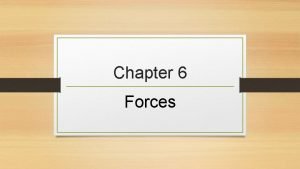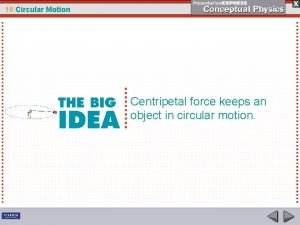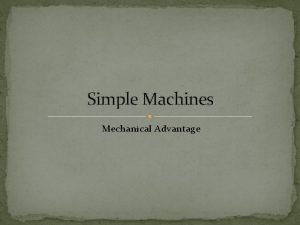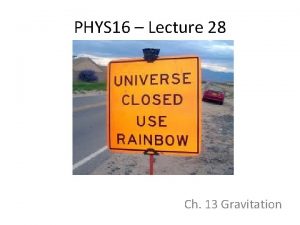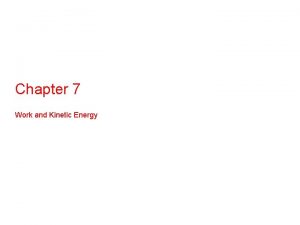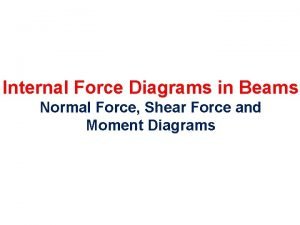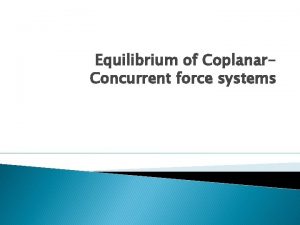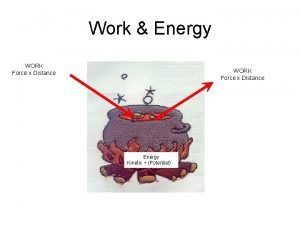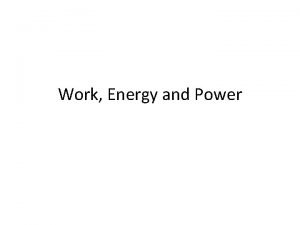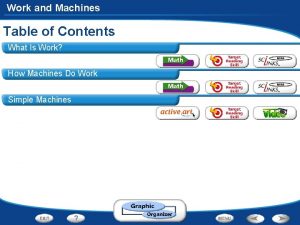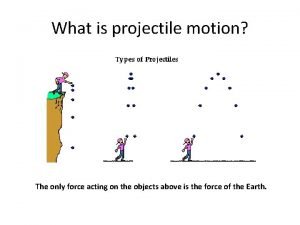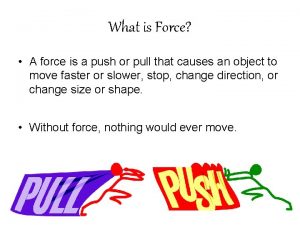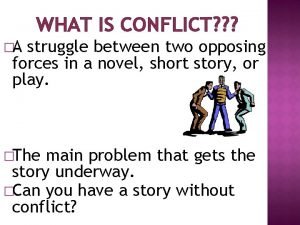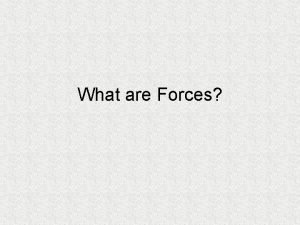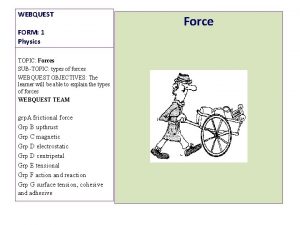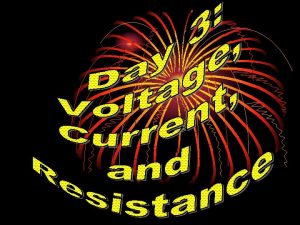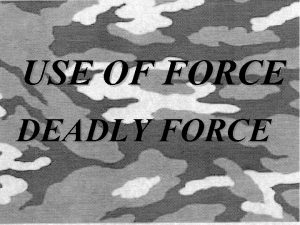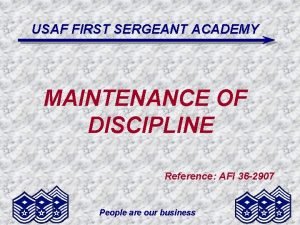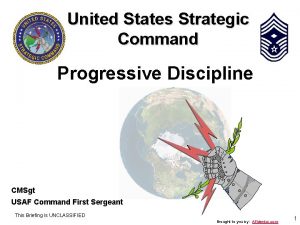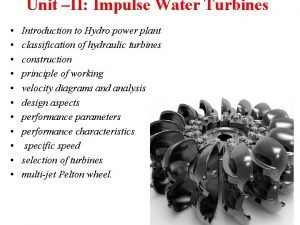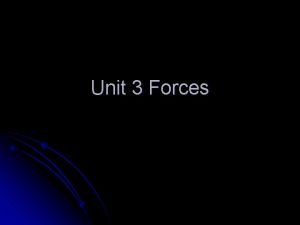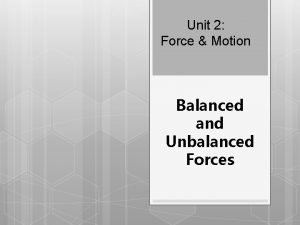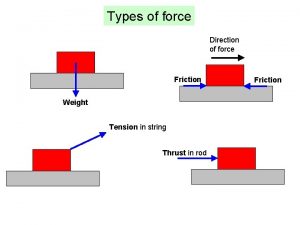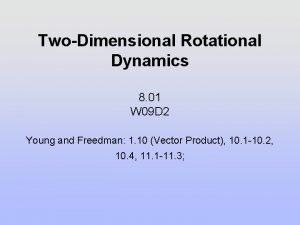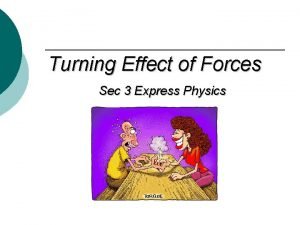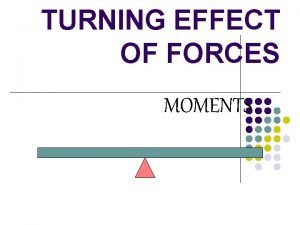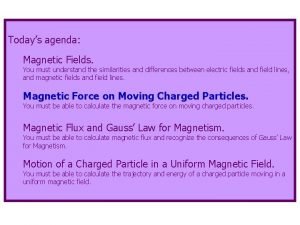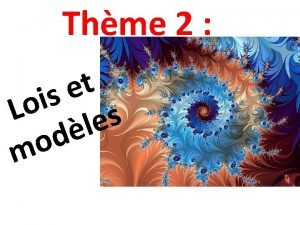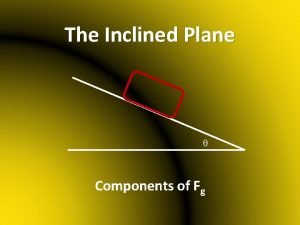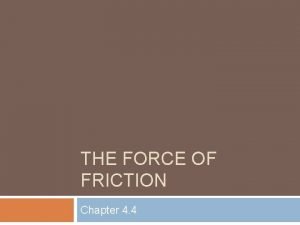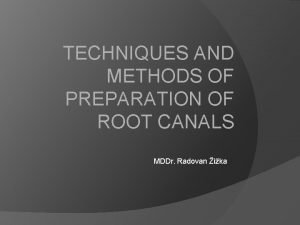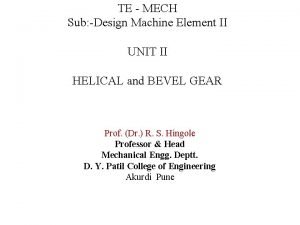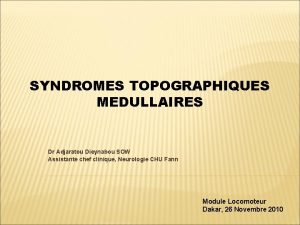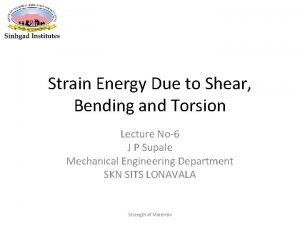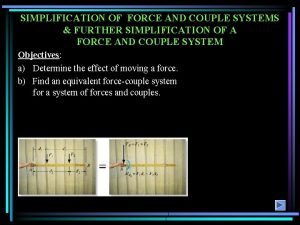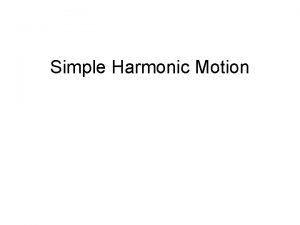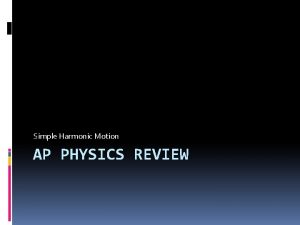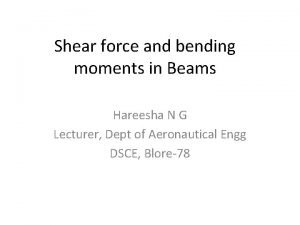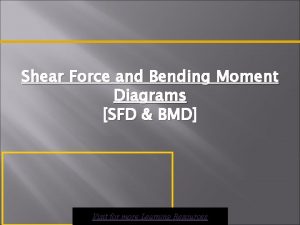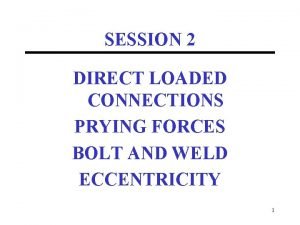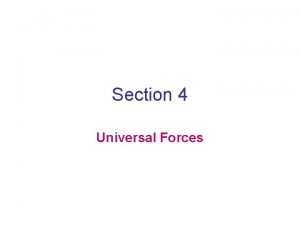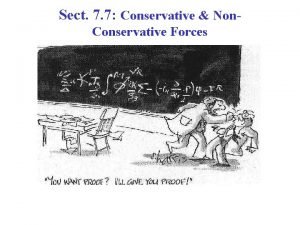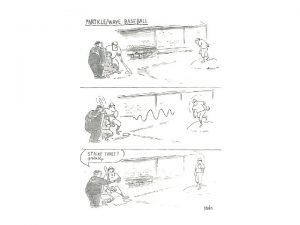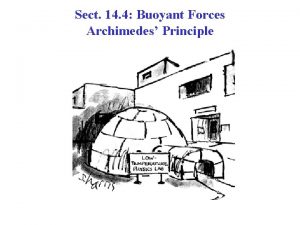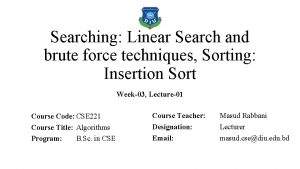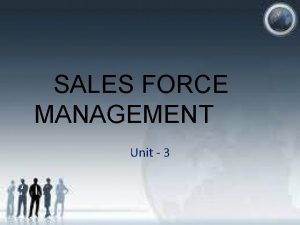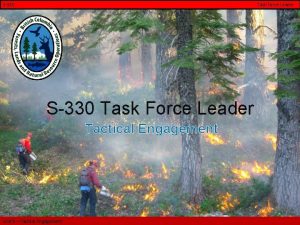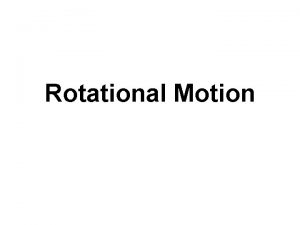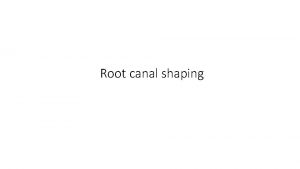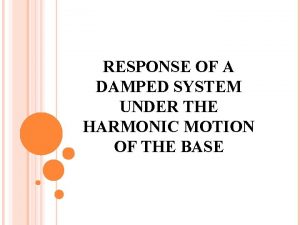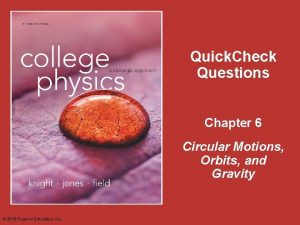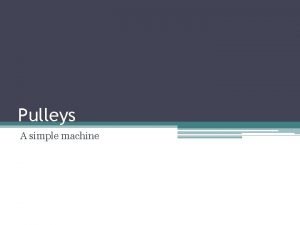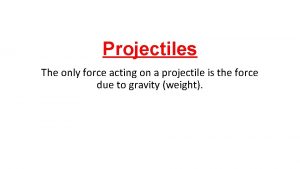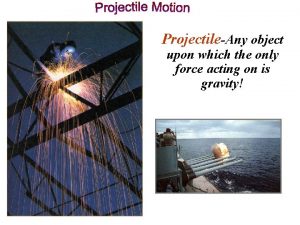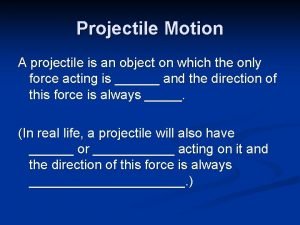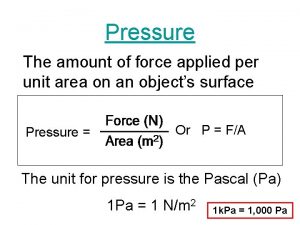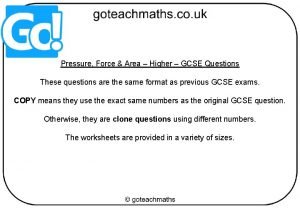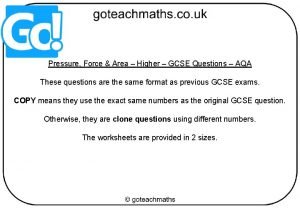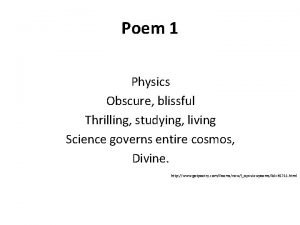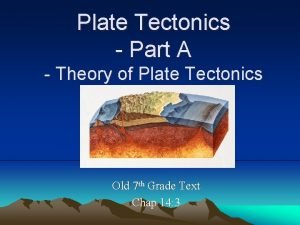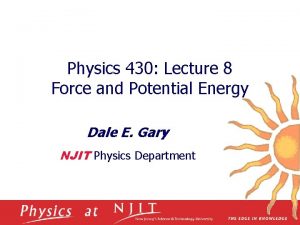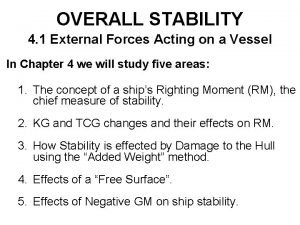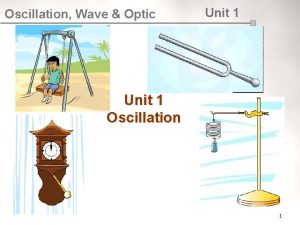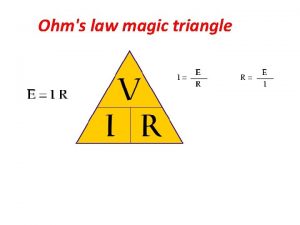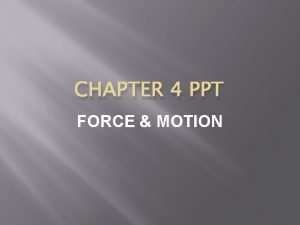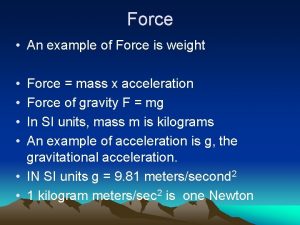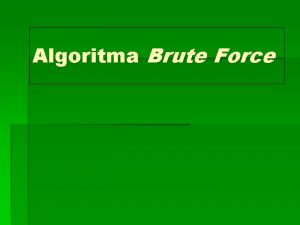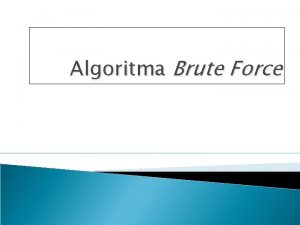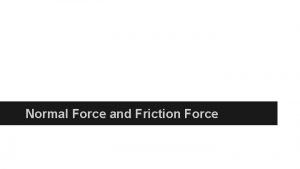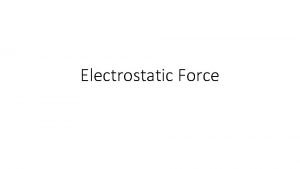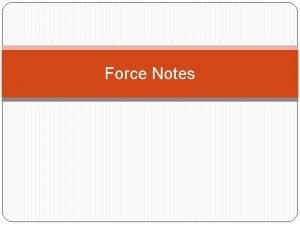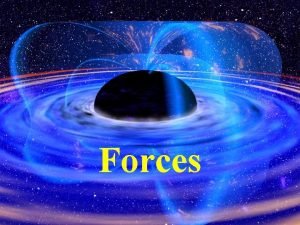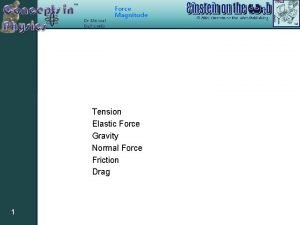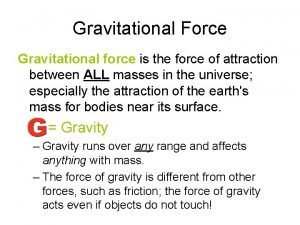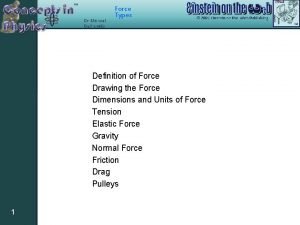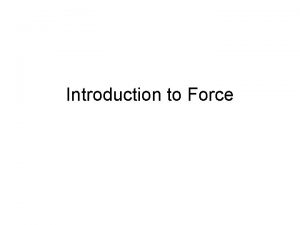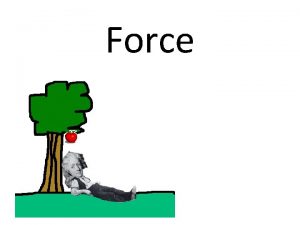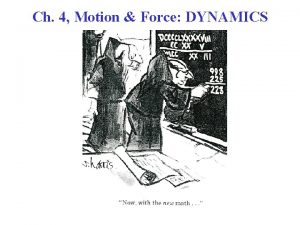FORCE SYSTEMS 2 D Force Systems 3 D







































































































- Slides: 103

FORCE SYSTEMS 2 -D Force Systems 3 -D Force Systems Force Moment, Couple Resultants 1

3 D-Force Systems Rectangular Components, Moment, Couple, Resultants 2

Moment (3 D) moment axis X Moment about point P : Y -Magnitude: d P O -Direction: right-hand rule -Point of application: point O (Unit: newton-meters, N-m) In 3 D, forces (generally) are not in the same plane. In many cases on 3 D, d (the perpendicular distance) is hard to find. It is usually easier to find the moment by using the vector approach with cross product multiplication. 4

Cross Product - - + + - + Beware: xyz axis must complies with right-hand rule 5

Moment (Cross Product) Physical Meaning + z Fz x Fy A + Fx rz y rx O y + ry z Mx = - Fyrz + Fzry My = +Fxrz - Fzrx Mz= -Fxry +Fyrx x 6

Moment About a Point #4 z O Resultant Moment of Forces y x 7

Varignon’s Theorem (Principal of Moment) - Two or more concurrent forces r O - their moments about a point may be found in two ways A - for nonconcurrent forces see Resultants sections (2 D - 2/6, 3 D- 2/9) - Sum of the moments of a system of concurrent forces about a given point equals the moment of their sum about the same point 8

Determine the vector expression for the moment of the 600 -N force about point O. The design specification for the bolt at O would require this result. Ans 9

x y MO z 6 m O r. OP 400 N 1. 2 m 0. 8 m P N-m Ans 10

z x y 6 m MO O r. OQ 400 N 1. 2 m 0. 8 m Q VD 2 N-m Ans 11

plus rx rz N-m Ans Not-Recommended Method 12

Moment Example Hibbeler Ex 4 -4 #1 Determine the moment about the support at A. 13

Moment Example Hibbeler Ex 4 -4 #2 14

Moment Example Hibbeler Ex 4 -4 #3 15

Moment Example Hibbeler Ex 4 -4 #4 16

z x Moment about Point y Moment about line ( projection effect ) 18

Finding moment of force about (arbitary) axis O Depend on line l only, Not depend on point O , , are the directional cosines of the unit vector 19

B B F F A A (generally) Moment of about point {A, B} in the direction of l where A, B on line l Moment of in the direction of l projected to line l about line l where A, B are any points on the line l Moment about axis is sliding vector. 20

Finding moment of force about (arbitary) axis O Depend on line l only, Not depend on point O , , are the directional cosines of the unit vector 22

Moment about Point P moment axis X Moment about line l (Definition) Line (moment axis) X Direction: right-hand rule d P O d How to find “Moment about line l” ? Q A A : Any point on line Hard to find

Moment about line l We will prove that Line (moment axis) X A : Any point on line is equal to Moment of about point {A, Q} projected to line l d Q A A : Any point on line must prove to be

Moment about line l Line (moment axis) is equal to X Point A is any point in the line l d Moment about axis is sliding vector. Q A where A, B are any points on the line l Moment of about point A in the direction of l Moment of about line l in the direction of l projected to line l

27

Find of (the moment of passing through the base O ) y about z-axis A 15 m T = 10 k. N O Ans x z 9 m 12 m OK B Figure must be shown OK not OK OK 28

2/133 A 5 N vertical force is applied to the knob of the window-opener mechanism when the crank BC is horizontal. Determine the moment of force about point A and about line AB. y 25 cos 30 mm C’ A r D’ D’ r 75 mm B’ 50 cos 30 x mm N-mm Ans N-mm 29

Moment Example Hibbeler Ex 4 -8 #1 Determine the moments of this force about the x and a axes. 30

Moment Example Hibbeler Ex 4 -8 #2 31

Moment Example Hibbeler Ex 4 -9 #1 Determine the moment MAB produced by F = (– 600 i + 200 j – 300 k) N, which tends to rotate the rod about the AB axis. Vector r is directed from any point on the AB axis to any point on the line of action of the force. 32

Moment Example Hibbeler Ex 4 -9 #2 33

Moment Example Hibbeler Ex 4 -9 #3 Vector r is directed from any point on the AB axis to any point on the line of action of the force. 34

r A position vector: from A to point of application of the force X Y d Z position vector: from A to any point on line of action of the force. p F O r A d r Y Z X position vector: from any point on line l to any point on tline of action of the force. 36

parallel with line l O P Forces which interest or parallel with axis, do not cause the moment about that axis Why? 37

Couple is a summed moment produced by two force of equal magnitude but opposite in direction. d B A O magnitude and direction Do not depend on O from any point on line of the action to any point on the other line of action Moment of a couple is the same about all point Couple may be represented as a free vector. 39

The followings are equivalent couples F F F d/2 2 F 2 F F Every point has the equivalent moment. 2 D representations: (Couples) couple is a free vector M M 40

- Couple tends to produce a “pure” rotation of the body about an axis normal to the plane of the forces (which constitute the couple); i. e. the axis of the couple. - Couples obey all the usual rules that govern vector quantities. - Again, couples are free vector. After you add them (vectorially), the point of application are not needed!!! - Compare to adding forces (i. e. finding resultant), after you add the forces vectorially (i. e. obtaining the magnitude and direction of the resultant), you still need to find the line of action of the resultant (2 D - 2/6, 3 D - 2/9). 41

30 N 60 0. 0 6 m x 0. 0 4 m 0. 05 m y 25 N 0. 1 m (forces act parallel to y-z plane) z 1) Replace the two couples with a single couple that still produces the same external effect on the block. 2) Find two forces and on two faces of the block that parallel to the y-z plane that will replace these four forces. (25)(0. 1)= 2. 5 N-m 60 M y z 60 M (30)(0. 06)= 1. 8 N-m 42

Moment Example Hibbeler Ex 4 -13 #1 Replace the two couples acting on the pipe column by a resultant couple moment. 43

Moment Example Hibbeler Ex 4 -13 #2 44

y MO, F z 200 mm 1200 N r MO, 240 N-m O 30 O 240 N-m x 250 mm Vector Diagram N-m Ans 45

Concepts #1 Review • Vectors can be manipulated by scalar multiplication, addition, subtraction, dot product, cross product and mixed triple product. Vectors representing can be classified into free, sliding and fixed vectors. • Position vectors describe the position of a point relative to a reference point or the origin. • Statically, force is the action of one body on another. In dynamics, force is an action that tends to cause acceleration of an object. To define a force on rigid bodies, the magnitude, direction and line of action are required. Thus, the principle of transmissibility is applicable to forces on rigid bodies. 46

Concepts #2 Review • To define a moment about a point, the magnitude, direction and the point are required. To define a moment about an axis, the magnitude, direction and the axes are required. To define a couple, the magnitude and direction are required. 47

Chapter Objectives Descriptions #1 • Use mathematical formulae to manipulate physical quantities – Specify idealized vector quantities in real worlds and vice versa – Obtain magnitude, direction and position of a vector – Manipulate vectors by scalar multiplication, addition, subtraction, dot product, cross product and mixed triple product – Describe the physical meanings of vector manipulations • Obtain position vectors with appropriate representation. 48

Chapter Objectives Descriptions #2 • Use and manipulate force vectors – Identify and categorize force vectors – Describe the differences between force representation in rigid and deformable bodies – Identify and represent forces in real worlds with sufficient data and vice versa – Manipulate force vectors 49

Chapter Objectives Descriptions #3 • Use and manipulate moment vectors – Identify and categorize moment vectors – Describe the differences between moments about points, moments about axes and couple – Identify and represent moments in real worlds with sufficient data and vice versa – Manipulate moment vectors 50

Review Quiz #1 Review • Use mathematical formulae to manipulate physical quantities – Give 4 examples of vector quantities in real world. – In how many ways can we specify a 2 D/3 D vector? Describe each of them. – How can we prove that two vectors are parallel? – What are the differences between the vector additions by the parallelogram and triangular constructions? – Even though we can manipulate vectors analytically, why do we still learn the graphical methods? 51

Review Quiz #2 Review • Use mathematical formulae to manipulate physical quantities – What are the mathematical definitions of dot, cross and mixed triple products? – What are the physical meanings of addition, subtraction, dot product, cross product and mixed triple product? – What are the meanings of associative, distributive and commutative properties of products? – What are the differences between 2 D and 3 D vector manipulation? 52

Review Quiz #3 Review • Obtain position vectors with appropriate representation. – Given points A and B, what information do you need to obtain the position vector and what name will you give to the position vectors and distance vector between the two points? 53

Review Quiz #4 Review • Use and manipulate force vectors – For the following forces – tension in cables, forces in springs, weight, magnetic force, thrust of rocket engine, what are their classification in the following force types – external/internal, body/surface and concentrated/distributed forces? – If a surface is said to be smooth, what does that mean? – What are the differences between force representation in rigid and deformable bodies? – What are the additional cautions in force vector manipulation that are not required in general vector manipulation? 54

Review Quiz #5 Review • Use and manipulate moment vectors – Give 5 examples of moments in real world and approximate them into mathematical models. – What information do you need to specify a moment? – What is the meaning of moment direction? – If a force passes through a point P, what do you know about the moment of the force about P? – What are the differences between physical meanings of moments about points, moments about axis and couples? 55

Review Quiz #6 Review • Use and manipulate moment vectors – As couples are created from forces, why do we write down the couple vectors instead of forces in diagrams? – Given a couple of a point P, what do you know of the couple about a different point Q? – If we know moments about different points or axes, why can’t we add components of moments as in vector summation? – Why can we simply add couple components together? 56

Resultant Definition • The “force-couple systems” or “force systems” can be reduced to a single force and a single couple (together called resultant) that exert the same effects of – Net force ç Tendency to translate – Net moment ç Tendency to rotate • Two force-couple systems are equivalent if their resultants are the same. 57

Force – Couple Systems B A B A No changes in the net external effects : Couple of calculated the same way as “Moment of Point B by the force F at the old position” about point B from new location (point B) to any point on the line of action of (which applied at the old point) 59

R MO Vector diagram Move 3 forces to point O Ans 60

Resultant Example Hibbeler Ex 4 -15 #1 Replace the current system by an equivalent resultant force and couple moment acting at its base, point O. 61

Resultant Example Hibbeler Ex 4 -15 #2 62

Resultant Example Hibbeler Ex 4 -15 #3 63

Recommended Problems • 3 D Moment and Couples: 2/124 2/125 2/129 2/132 64

Wrench Resultant O O 1) Pick a point (easy to find moment arms) - 2) Replace each force with a force at point O + a couple start from ______ O 3) Add the forces vectorially to get the resultant force (since the forces are concurrent now) and add the couple vectorially to get the resultant couple to_______ 66

O Vector Scalar (2 D * 3 Plane) 67

- The choice of point O is arbitrary; the resultant couple will not be the same for each point O selected (in general), but the resultant force will be the same. O Ex) - The resultant couple cannot be cancelled by moving the resultant force (in general). X M which // R, cannot be cancelled M which |_ R, can be cancelled. Wrench Resultant (not very useful) - All force systems can be represented with a wrench resultant as shown in the figures Positive if right-hand rule Positive wrench Negative wrench 68

How to find Wrench Resultant M-R d plane O O O Plane Containing and Vector approach see ex. 2/16 with M-R plane How to find ( knowing ) O 69

The simplest form of force-couple system 3 D any forces + couples system single-force + single couple (which // with each other) wrench resultant 2 D any forces + couples system single-force system (no-couple) O OR single-couple system Why 2 D is different from 3 D? 70

Special cases: Wrench Resultant O 1) Coplanar: 2 D (Article 2/6) O 2) Concurrent force: the resultant will pass through the point of concurrency. No resultant moment at concurrent point. Pick the point of concurrency! 3) Parallel forces (not in same plane): single-force system (no-couple) z x O y OR single-couple system 71

Sample problem 2/13 Find the resultant z 50 N Move all force to point O 70 N-m 100 N-m 80 N 50 N 80 N x 96 N-m 1. 2 O 1. 6 100 N 1 100 N y pass thru O: no need to calculate couple Ans 72

50 N z Find the resultant Move all force to point O x O 500 N . 35 y 300 N 200 N . 35 0. 5 Moving R can erase M completely 0. 5 z New point: (x, y, z) x R y R |_ M O M Which quadrant? 73

74

Find the wrench resultant, give coordinates on x-y plane that the wrench resultant acts. Solution 0 (Wrong) Move all force to point O z y O x Move R to point P (x, y, z), to cancel the couple z y x O P unable to solve!! z y x Generally in 3 D, we can not change force-couple system to single-force system. 75

Find the wrench resultant, give coordinates on x-y plane that the wrench resultant acts. Solution 1: Direct Method z Move all force to point O y O x negative wrench O 76

Find the wrench resultant, give coordinates on x-y plane that the wrench resultant acts. O new point P: (x, y, z) O old point O: (0, 0, 0) line of action Ans 77

Find the wrench resultant, give coordinates on x-y plane that the wrench resultant acts. Solution 2: Equivalent System Assume (x, y, 0) is the point where wrench passes. z y x O Parallel Condition P y M (+ or – is ok) x 78

Find the wrench resultant, give coordinates on x-y plane that the wrench resultant acts. The coordinate in x-y plane, where wrench resultant passes Magnitude: 2. 4 N-m (negative wrench) Ans Direction: opposite with R (negative wrench) 79

Find the wrench resultant, give coordinates on x-y plane that the wrench resultant acts. Solution 3: wrench condition Move forces to P (x, y, 0) z wrench condition y x O P P y x Take it as the other unknown 80

Find the wrench resultant, give coordinates on x-y plane that the wrench resultant acts. M (+ or – is ok) The coordinate in x-y plane, where wrench resultant passes Magnitude: 2. 4 N-m (negative wrench) Ans Direction: opposite with R (negative wrench) 81

Hibbeler Ex 4 -136 The three forces acting on the block each have a magnitude of 10 N. Replace this system by a wrench and specify the point where the wrench intersects the z axis, measured from point O. y erasable x Positive wrench Ans 82

Hibbeler Ex 4 -136 M|| D FR A d B 83

Equivalent System Example Hibbeler Ex 4 -136 #1 The three forces acting on the block each have a magnitude of 10 N. Replace this system by a wrench and specify the point where the wrench intersects the z axis, measured from point O. 84

Equivalent System Example Hibbeler Ex 4 -136 #2 85

Equivalent System Example Hibbeler Ex 4 -136 #3 86

Equivalent System Example Hibbeler Ex 4 -136 #4 87


Equivalent System Reduction Summary Single force + single couple General force systems 2 D force systems Single force or single couple simplest systems 3 D force systems Wrench 89

A flagpole is guyed by 3 cables. If the tensions in the cables have the same magnitude P (N), replace the forces exerted on the pole with an eqivalent wrench and determine the resultant force R and the point where the axis of the wrench intersects the x-z plane Assume (x, 0, z) is the point where wrench passes. y z x P: (x, 0, z) 90

y z x P: (x, 0, z) 91

wrench condition M (+ or – is ok) y z x P: (x, 0, z) 92

y R z O MO 2. 4 m VD 1 1600 N 0. 9 m 800 N x M has no component in the direction of R. We can move R to new position to eliminate this couple completely 93

y R z O MO 1600 N 0. 9 m 2. 4 m 800 N x VD 1 y R z O MO R r x VD 2 Ans 94

z x F a O R MO b F c y VD 1 We move R to the new location (x, y, z) where there is no couple. Generally b != 0, how come? Generally in 3 D, we can not change force-couple system to single-force system. 95

MO x z x R F a O R b F c y VD 1 MO O r VD 2 M y Ans Note: we can calculate wrench just in 1 step see sample 2/16. 96

Recommended Problems • 3 D Resultants: 2/140 2/142 2/149 2/150 98

Equivalent System A A ? B B P P C force-couple System A C force-couple System B In Statics Mechanics, we treat these two systems are equivalent if and only if (Pure Tendency to translate) (Pure Tendency to rotate) (in fact, just any one point is ok) (just one point, and can be any point)

Equivalent System useful for reducing any force-couple system => simplest resultant - General (3 D) Force System - Concurrent Force System - Parallel Force System - Coplanar Force System (2 D System) 101

General-3 D Force Systems simplest system z y x O P y x 102

Concurrent Force Systems (and no couple) simplest system O O No benefit to use, because it is satisfied by default (moment at O) 103

Coplanner System simplest system x O x y y O for most case (99. 9%) (Moment at point O) 104

105

Equivalent System Example Hibbeler Ex 4 -16 #1 Determine the magnitude, direction and location on the beam of a resultant force which is equivalent to the system of forces measured from E. 106

Equivalent System Example Hibbeler Ex 4 -16 #2 107

Equivalent System Example Hibbeler Ex 4 -16 #3 108

Equivalent System Example Hibbeler Ex 4 -19 #1 Determine the magnitude and direction of a resultant equivalent to the given force system and locate its point of application P on the cover plate. System II 109

Equivalent System Example Hibbeler Ex 4 -19 #2 110

Equivalent System Example Hibbeler Ex 4 -19 #3 111

Equivalent System Reduction 3 D System to a Wrench #1 112

Equivalent System Reduction 3 D System to a Wrench #2 113
 Is tension contact or noncontact
Is tension contact or noncontact Which arrow below represents the direction of acceleration
Which arrow below represents the direction of acceleration Long range force
Long range force If you whirl a tin can on the end of a string
If you whirl a tin can on the end of a string The ratio of resistance force to effort force
The ratio of resistance force to effort force Net force
Net force Centripetal vs centrifugal
Centripetal vs centrifugal Whats a noncontact force
Whats a noncontact force Why electric field is conservative
Why electric field is conservative Centripetal force and gravitational force
Centripetal force and gravitational force Hooke's law vector form
Hooke's law vector form Normal force diagram beam
Normal force diagram beam Non concurrent coplanar forces
Non concurrent coplanar forces Engineering mechanics chapter 2
Engineering mechanics chapter 2 Force system resultants chapter 4
Force system resultants chapter 4 Equilibrium of coplanar force system
Equilibrium of coplanar force system Decision support systems and intelligent systems
Decision support systems and intelligent systems Engineering elegant systems: theory of systems engineering
Engineering elegant systems: theory of systems engineering Embedded systems vs cyber physical systems
Embedded systems vs cyber physical systems Elegant systems
Elegant systems The force exerted on an object by a machine
The force exerted on an object by a machine Quantity force x distance
Quantity force x distance Efficiency formula
Efficiency formula Input force definition physics
Input force definition physics What is the force distance trade off
What is the force distance trade off Work equals force times distance
Work equals force times distance What is a complex machine example
What is a complex machine example The only force acting on a projectile
The only force acting on a projectile Type of force applied
Type of force applied What is the struggle between two opposing forces?
What is the struggle between two opposing forces? What two factors affect the force of friction
What two factors affect the force of friction Forces webquest
Forces webquest Force 8 wind
Force 8 wind Def voltage
Def voltage 7 justifications of deadly force navy 2019
7 justifications of deadly force navy 2019 Usaf progressive discipline
Usaf progressive discipline U.s. army structure
U.s. army structure Force musculaire cotation
Force musculaire cotation Air force progressive discipline model
Air force progressive discipline model Air force reserve crna
Air force reserve crna Reaction and impulse turbine difference
Reaction and impulse turbine difference Force mass acceleration triangle
Force mass acceleration triangle What is balanced force
What is balanced force Force preservation council
Force preservation council Friction
Friction Tangential force formula
Tangential force formula Principle of moment
Principle of moment Moments in physics
Moments in physics Magnitude of magnetic field
Magnitude of magnetic field Magnitude of magnetic force
Magnitude of magnetic force Force conservative
Force conservative Inclined plate clarifier
Inclined plate clarifier It is created by the force of moving water
It is created by the force of moving water Force friction equation
Force friction equation Foramen fysiologicum
Foramen fysiologicum Tredgold approximation
Tredgold approximation épreuve de queckenstedt-stookey
épreuve de queckenstedt-stookey 500n
500n The strain energy due to shear is expressed by
The strain energy due to shear is expressed by A tow truck exerts a force of 2000n on a car
A tow truck exerts a force of 2000n on a car Space force bases map
Space force bases map Couple system
Couple system Simple harmonic motion springs
Simple harmonic motion springs Ap physics 1 shm review
Ap physics 1 shm review Moment at roller support
Moment at roller support Sfd and bmd diagram for cantilever beam
Sfd and bmd diagram for cantilever beam Prying force
Prying force Which universal force can repel as well as attract?
Which universal force can repel as well as attract? Conservative force
Conservative force Scattering in a central force field
Scattering in a central force field Site:slidetodoc.com
Site:slidetodoc.com Is linear search a brute force algorithm
Is linear search a brute force algorithm Mobile field force formations and commands
Mobile field force formations and commands Force management definition
Force management definition Aplikasi sales force automation
Aplikasi sales force automation Nwcg s-330
Nwcg s-330 Rowenta silence force extreme ro6477ea aaaa
Rowenta silence force extreme ro6477ea aaaa If you cannot exert enough torque to turn a stubborn bolt
If you cannot exert enough torque to turn a stubborn bolt Balanced force technique
Balanced force technique Resultant of two like parallel forces
Resultant of two like parallel forces Damped system under harmonic force
Damped system under harmonic force Who is included in the labor force
Who is included in the labor force A coin sits on a turntable
A coin sits on a turntable What is uses of pulley
What is uses of pulley Capillary action
Capillary action What is the only force acting on a projectile
What is the only force acting on a projectile A projectile is an object upon which the only force is
A projectile is an object upon which the only force is Define projectile motion in physics
Define projectile motion in physics The only force acting on a projectile
The only force acting on a projectile Progressive discipline flow chart
Progressive discipline flow chart The amount of force applied per unit of area
The amount of force applied per unit of area Gcse pressure questions
Gcse pressure questions Pressure gcse questions
Pressure gcse questions What is position vector
What is position vector Centrifugal force ap human geography
Centrifugal force ap human geography Physics poem
Physics poem Driving force of plate tectonics
Driving force of plate tectonics Force exerted by jet on moving plate formula
Force exerted by jet on moving plate formula Weightlessness definition physics
Weightlessness definition physics Force is the integral of potential energy
Force is the integral of potential energy What is the external force on statical stability
What is the external force on statical stability Units for period of a pendulum
Units for period of a pendulum Force field theory
Force field theory Voltage current triangle
Voltage current triangle


